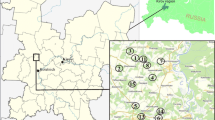Abstract
Without genetic tests of parentage, descriptions of mating systems must be considered hypothetical. Here we confirm the existence of cooperative polyandry in the Galapagos hawk (Buteo galapagoensis) using multilocus minisatellite DNA fingerprinting. In this species, breeding groups consist of one adult female and from one to eight males (the modal number of males is two). In polyandrous groups, all males copulate with the female and participate in the provisioning of the young. DNA samples from 66 individual hawks from ten breeding groups on the island of Santiago revealed mixed paternity in most groups. Multiple paternity was detected in five of six groups that produced two chicks in one breeding attempt (year). In addition, different males sired young in consecutive years in five of six groups in which male group membership was constant. Patterns of paternity suggest that reproductive success was randomly distributed among males within groups, with males apparently having equivalent probabilities of siring each young. Analysis of genetic similarity indicates that males within groups were typically not close relatives These results demonstrate that the mating system of the Galapagos hawk is polyandrous, with relatively egalitarian relations among unrelated males belonging to the same breeding group.
Similar content being viewed by others

References
Axelrod R, Hamilton WD (1981) The evolution of cooperation. Science 211:1390–1396
Birkhead TR (1987) Sperm competition in birds. Trends Ecol Evol 2:268–272
Birkhead TR, Moller AP (1992) Sperm competition in birds. Academic Press, London
Faaborg J (1986) Reproductive success and survivorship of the Galapagos hawk Buteo galapagoensis: potential costs and benefits of cooperatively polyandry. Ibis 128:337–347
Faaborg J, Patterson CB (1981) The characteristics and occurrence of cooperative polyandry. Ibis 123:477–484
Faaborg J, Vries Tj de, Patterson CB, Griffin CR (1980) Preliminary observations on the occurrence and evolution of polyandry in the Galapagos hawk (Buteo galapagoensis). Auk 97:581–590
Georges M, Lequarre A-S, Castelli M, Hanset R, Vassart G (1988) DNA fingerprinting in domestic animals using four different minisatellite probes. Cytogenet Cell Genet 47:127–131
Hamilton WD (1964) The genetical evolution of social behaviour. I, II. J Theoret Biol 7:1–52
Jeffreys AJ, Wilson V, Thein SL (1985a) Hypervariable ‘minisatellite’ regions in human DNA. Nature 314:67–73
Jeffreys AJ, Wilson V, Thein SL (1985b) Individual-specific ‘fingerprints’ of human DNA. Nature 316:76–79
Jeffreys AJ, Royle NJ, Wilson V, Wong Z (1988) Spontaneous mutation rates to new length alleles at tandem-repetitive hypervariable loci in human DNA. Nature 332:278–281
Lima SL (1989) Iterated prisoner's dilemma: an approach to evolutionarily stable cooperation. Am Nat 134:828–834
Longmire JL, Lewis AK, Brown NC, Buckingham JM, Clark LM, Jones MD, Meincke LJ, Meyne J, Ratliff RL, Ray FA, Wagner RP, Moyzis RK (1988) Isolation and molecular characterization of a highly polymorphic centromeric tandem repeat in the family Falconidae. Genomics 2:14–24
Lynch M (1990) The similarity index and DNA fingerprinting. Mol Biol Evol 7:478–484
Mantel N (1967) The detection of disease clustering and a generalized regression approach. Cancer Res 27:209–220
Oring LW (1982) Avian mating systems. Avian Biol 6:1–92
Packer C, Gilbert DA, Pusey AE, O'Brien SJ (1991) A molecular genetic analysis of kinship and cooperation in African lions. Nature 351:562–565
Rabenold PP, Rabenold KN, Piper WH, Haydock J, Zack SW (1990) Shared paternity revealed by genetic analysis in cooperatively breeding tropical wrens. Nature 348:538–540
Rohlf FJ (1990) NTSYS-pc: Numerical taxonomy and multivariate analysis system, version 1.60. Applied Biostatistics, Setauket
Schnell GD, Watt DJ, Douglas ME (1985) Statistical comparison of proximity matrices: applications in animal behaviour. Anim Behav 33:239–253
Westneat DF, Sherman PW, Morton ML (1990) The ecology and evolution of extra-pair copulations in birds. Curr Ornithol 7:331–369
Wetton JH, Carter RE, Parkin DT, Walters D (1987) Demographic study of a wild house sparrow population by DNA fingerprinting. Nature 327:147–149
Author information
Authors and Affiliations
Rights and permissions
About this article
Cite this article
Faaborg, J., Parker, P.G., DeLay, L. et al. Confirmation of cooperative polyandry in the Galapagos hawk (Buteo galapagoensis). Behav Ecol Sociobiol 36, 83–90 (1995). https://doi.org/10.1007/BF00170712
Received:
Accepted:
Issue Date:
DOI: https://doi.org/10.1007/BF00170712


